Brief Aan
Dear Michel,
On the 25th of August 2014, I visited your retrospective at De Hallen Haarlem. As I sat down on a bench and stared at the wall my gaze was taken to a rooftop in a foreign land. In the foreground two young women, dressed loosely in linen, swayed back and forth. Whilst behind them, in the distance, the tips of prayer towers varied in height. My eyes then started to wander the ground in between and soon they settled on a curious form subtly rocking in the shadows. The form was a human but the rocking had no obvious explanation.
By now the gaze of your camera had caught up with mine and the man filled the frame. A light then reflected off something in his hand and I recognized it to be a knife. It seemed familiar. Then it struck me. The knife was mine and the man was me.
After the immediate epiphany of realizing myself as a character in your film I felt nothing. My identity was not synonymous with that human. Its actions were not tied to me. I thought back to the other works I had seen and the displacement of an action from its casual Cosmos began to echo through the rooms. Sure, in Untitled (I Was Looking Back To See If You Were Looking Back At Me To See Me Looking Back At You) it’s obvious, but what about when you film your daughter, could we also say that at times, casually riddling gibberish in front of the lens, she becomes merely a symbol? A character of a daughter? And if we can, I’m curious as to how you achieve the necessary distance to do this?
Anyway, back to the rooftop. It was the early 70s. I had strayed from the hippy trail and ended in Salé, Morocco. I even remember that night and a man with a camera sitting next to me and filming the Moroccan knife salesman I was speaking to. With a coy grin the salesman told a story of how he’d once tried to sell a knife to a man and to show him how good it was, stabbed him to death. He was constructing a barbarous caricature for you and I was wondering Michel, why did you not include it? Or, come to think of it, what happened to the moment when you fell off your stool and lying there, pressed record to capture the sky?
This thought reminded me of a scene in the novel Cosmos by Witold Gombrowicz. As Witold lies on the bed he stares up at the ceiling and focuses on an inconspicuous line. He does this long enough for the line to transform into an arrow. This arrow then waits until it is eventually called forward to provide meaning in an undefinable investigation.
Anyway, days later, I was sitting at home when a song by Neil Young began to play.
“I heard a perfect echo die into an anonymous wall of digital sound (…)”
Halfway through a fierce one note solo I realized I my body was rocking and my thoughts returned to Salé. I typed your name into google and entered a blog of photographs documenting your studio in Brooklyn. It looked more like an archive; An anonymous wall of 5,000 tapes. I continued to scroll through the blog…
“(…) went to the rodeo today. I saw the cowgirls lined up on the fence. A brand new Chevrolet. A brand new pair of seamless pants (…)”
…then stopped on an image. A gloss print leans against a cluster of cassette tapes. The print presents yourself bleary-eyed, slumped over a woman and the cassettes are labeled “Coquettes A 71, Coquettes B 71, Coquettes C 71”… What does the word “Coquettes” mean? The internet says a female flirt, a hummingbird of the genus Lophornis and a vehicle in Grand Theft Auto IV and V which is a parody of the Chevrolet Corvette… None of this makes much sense but it gets me thinking, what would it mean to call this index a dictionary? Like a dictionary the word-images sit dormant, awaiting intonation. And like a dictionary these 5,000 hours are, as you say, “merely a drop in the (representational) ocean”.
If we go with this Michel, my question is how you perceive your vocabulary when sculpting these words? It fluctuates greatly, but does this mean it avoids alignment to a single culture? Poetic intuition is replaced by calculated combinations and vice versa. You have spoken about your construction of personal truths, but what about when you deal with displaced relics of the broader human condition? And what happens when you deal with these from the position of the outsider? The subsequent freedom outside the depicted realities provides the possibilities of both subversion and totalitarianism over its content and thus it seems fitting that I came upon all of this in De Hallen Haarlem (the birth place of Jan Janszoon – the 17th century Dutch sailor who became a feared Muslim pirate).
Best,
Jacob
Jacob Dwyer
is kunstenaar




















